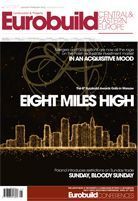Leading not lagging
Endpiece
A bottle of wine was auctioned FOR PLN 75,000 at the Eurobuild Awards Gala two years ago. (That’s just one bottle, not a thousand of them.) It was purchased by Panattoni Europe and the money went to children in need. “Oh, the sector must be doing well,” – I thought at the time and indeed it did turn out to be a promising sign for the market. The next year or two have been very good for Panattoni and the entire real estate business. I think that the charity auction of a bottle of wine at the Eurobuild Awards Gala each year could have been used as a real estate business barometer – just like the groundhog being spooked or not by its own shadow in the film starring Bill Murray – if the format hadn’t been changed since then. In fact, a painting was the main item at the most recent auction instead of a bottle of wine – and the bidders turned out to be much more cautious. This time in order to buy the item Panattoni ‘only’ had to cough up PLN 25,000.
Does this mean that the market is set for a downturn? Let’s hope not. Our hope lies in what we know of similar forecasts – they are interesting but you cannot rely on them. Of course, they are interesting because leading indicators, contrary to what are termed lagging indicators (like GDP growth, the unemployment rate and the investment ratio in a given year) are used to predict what will happen in the future. But they are unreliable because even one of the most serious surveys of leading indicators globally, the American Conference Board Leading Economic Index, predicted twelve recessions in the last four decades of the 20th century... but five of these were false alarms. A malicious person might say that seven good shots out of twelve isn’t much better than tossing a coin.
However, let’s not be too quick to dismiss leading indicators. Let’s focus on the fact that they are interesting. One major untypical indicator, funnily enough, turns out to be cardboard boxes. All you need to do is to find out how many boxes companies are ordering to work out what the economic climate is likely to be over the next month. Clearly, when retailers are expecting a greater number of orders, they will buy more cartons. Therefore, before we have the actual sales data (a lagging indicator), we can predict its increase or decline based on the number of boxes required. Clever, isn’t it? Or let’s take the more real estate-oriented Barclays Skyscraper Index. This is based on the notion that construction booms – in particular in the construction of the tallest skyscrapers in the world – have been observed to indicate an imminent crash. Three huge skyscrapers were built before the Wall Street Crash of 1929: 40 Wall Street (since renamed the Trump Building), the Chrysler Building and the Empire State Building, while the construction of Burj Khalifa started before the Credit Crunch.
I don’t know about you, but frankly speaking I am not convinced by the Skyscraper Index. However, I’m inclined to say that journalists would be the first to know if any recession takes place. And this would be thanks to a custom that has been observed for several years. Every year in the run-up to Christmas, publications such as ourselves receive seasonal greetings from companies whose PR specialists hope to foster, let’s say, the good will of the press. However, a journalist should be as squeaky clean and as above suspicion as Caesar’s wife – and even small gifts can raise a few eyebrows. And these greetings are sometimes accompanied with a little something to eat or... drink. Whether they should be sent back or not will have to be the subject of another article, but I can only say that if someone ever devised an index of the greetings being sent to various trade magazines each year, they would probably be able to gauge the level of optimism among companies from how much they have lavished on this form of PR exercise – since marketing and PR budgets tend to be the first to be cut if a recession is on the cards.
So, allowing for a small correction in the information I have (because I only work for one publication), and taking into account everything I have said about leading indicators, I can say with some degree of confidence that the year ahead of us is going to be a good one.





















































